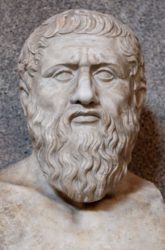Teleology and pseudo-ontology
Teleology is looking at things by their purpose. It is not the direct causal meaning, that is: the elements in relation are the origin and cause the result. In teleology the starting point is the result. The elements are only the intermediaries to achieve this. Inescapably.
Teleology is characteristic of the mind. It is it who sees the purpose of things so in fact the raison d’être of things. Is this way exclusive to the mind? A priori not. Things do the same by associating themselves by their properties, which are the result of their constitution. For example, when two biomolecules associate each other with their spatial conformation, this reality does not exist in view of subatomic forces. The subatomic forces themselves are the purpose of an underlying constitution that is unknown to us.
When we call these forces “fundamental”, it is a reality that we have created teleologically. Science speaks of ‘ontological’ forces, because matter seems to obey them perfectly. But they are anchors that the mind has laid in the depths of reality per se. It is not accessible and science cannot formally state that these forces are its essence.
Since our representation of reality is entirely of teleological origin, things seem to us to do the same to associate. They recognize themselves by their properties. But it must be borne in mind that reality per se could hold a different discourse. What we call the ‘ontology’ of things is a pseudo-ontology.
Upward and downward complexity
To avoid confusion I call ‘downward’ the teleological look and ‘upward’ the pseudo-ontological look. The verticality of these looks is that of the complex dimension, matter at the base, spirit at the top. These two actors act on each other: matter constitutes the mind, the mind sees the results and tries to act on the matter to influence them. Its intention is a retro-control.
To intervene, the mind also lends intentions to matter, which it calls its ‘properties’. It is always teleological. The disadvantage is that the properties are not constantly homogeneous. Referring their changes to the context is quite easy. It is more difficult when matter changes for intrinsic reasons. The mind postulates to him a stable constitution, true within certain limits.
In summary , the downward look defines a thing by its properties, assumes that the intention of the thing is coherent, stable over the duration of observation. This is a useful approximation, but it can be expensive.
Slippage when coming to mind
The caricatural example is the human mind itself when it is analyzed by another. The observer attributes to the observed properties, gathered under the term ‘personality’. Particularly unstable properties leading to adventurous predictions.
What about observing a host of such spirits? They are brought together by collective consciousnesses, which make it possible to found entities such as ‘women’, ‘whites’, ‘religious’, ‘politicians’, etc. But the approximations then become caricatures, and the downward look should limit itself in its conclusions.
Does it do it? Too rarely. An opinion, after all, is a personal expansion. It represents the individual more than the thing. The individual appropriates the being of the thing instead of leaving it to it. In an author opinion is a detonation. She throws a bomb among the crowd, wants to transform reality into the simulation she designed. For this she must employ approximations, the reality per se being too complex. But we must make up the obvious, so as not to defuse the bomb.
The downward look cannot avoid this intrinsic defect: it manipulates a collective entity by lending it a coherent intention, which is risky. Women, men, assaulted, aggressors, libertarians, reactionaries, that people are grouped by phenotypes or behaviors does not mean that identical causes have provoked them. The intervention of the upward look is imperative. Are we really dealing with a homogeneous grouping in the context exposed? Ant work, as if it were necessary to examine each atom of a tree to define with certainty its continuity and its limits. It is impossible to circumvent such a task. The downward look is very practical: from the trunk to the end of the leaves he expresses “It’s one tree!”. But underground, in the inextricable network of roots, it’s not so easy anymore.
While the downward look sparkles with hard-hitting judgments under the pen of pamphleteers and activists, the upward look is used in the psychology cabinet, the personal diary, even the exchange of gossip or the tag written on the wall of the toilet. The details of a relationship appear there. No matter how true they are, this is how things were perceived and motivated actions. The role of the upward look is not to replace the judgment of the downward. It verifies that the interpretation is correct. While the two looks must meet, too often they cross paths or try to annihilate each other.
An example of these annihilation efforts follow this post. Militant feminists have so wanted to make female desire a unique entity that this artifice crumbles between their fingers. An exclusive downward look that annihilates the myriad of interweaving of feminine and masculine impulses with successful or unsuccessful outcomes.
*

